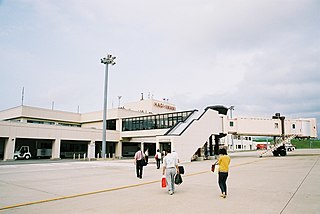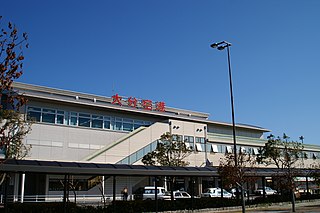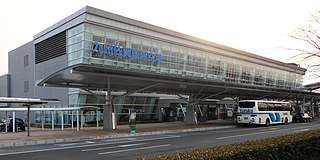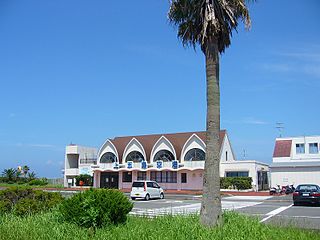
Hakodate Airport is an airport located 7.6 km (4.7 mi) east of Hakodate Station in Hakodate, a city in Hokkaidō, Japan. It is owned by the Ministry of Land, Infrastructure, Transport and Tourism and operated by Hokkaido Airports.

Toyama Airport is an airport located in the city of Toyama, Toyama Prefecture, Japan. It services are primarily domestic flights and international flights to China and Taiwan: however, seasonal international charter flights also service Toyama from April to June.

Naha Airport is an international airport located 4 km (2.5 mi) west of the city hall in Naha, Okinawa Prefecture, Japan. It is Japan's sixth busiest airport and the primary air terminal for passengers and cargo traveling to and from Okinawa Prefecture, Japan. It handles scheduled international traffic to Taiwan, Hong Kong, South Korea, Thailand, Malaysia, Singapore and mainland China. The airport is also home to Naha Air Base of the Japan Air Self-Defense Force.

Nagasaki Airport is an airport located off the coast of Ōmura, Nagasaki Prefecture, Japan. The airport was the first airport in the world to be built on the ocean, using an existing small island located in the center of Ōmura Bay, with land areas that were fully reclaimed.

Fukue Airport, is a third class airport located 1.7 NM southwest of Gotō, Nagasaki Prefecture, off the western coast of Kyūshū, Japan. The airport also serves the city of Fukue. It is also known as Gotō-Fukue Airport and, since 2014, also styled Gotō Tsubaki Airport (五島つばき空港). Currently the terminal building's exterior displays both names. Tsubaki means camellia, and is a notable reference on Fukue Island which is famed for producing camellia oil and is home to two ancient camellia trees each over 300 years old that have been declared 'national monuments'

Akita Airport is an airport located 14 km (8.7 mi) southeast of Akita Station, in Akita Prefecture, Japan.

Hachijojima Airport is a regional airport serving Hachijōjima in the southern Izu Islands, Tokyo, Japan.

Iwami Airport is an airport located 2.8 NM Masuda, Shimane Prefecture, Japan. It is also known as Hagi-Iwami Airport due to its proximity to the city of Hagi in Yamaguchi Prefecture. It is a 2 or 3 hour drive from the old town of Iwami, its primary namesake.

Kōchi Airport, also known as Kōchi Ryōma Airport, is a regional airport in Nankoku, a city in Kōchi Prefecture of Japan. It is located on the southeastern coast, 7 NM east of the city of Kōchi.

Miyazaki Airport, also known as Miyazaki Bougainvillea Airport, is an international airport located 3.2 km (2.0 mi) south southeast of Miyazaki city, in Miyazaki Prefecture, Japan. The second floor has the head office of Solaseed Air.

Oita Airport is an international airport in Kunisaki City, Ōita Prefecture Japan, 16 NM northeast of Ōita City.

Saga Airport is an airport in the Kawasoe area of Saga, Saga Prefecture, Japan. It also uses the unofficial name Kyushu Saga International Airport.

Yamagata Airport is an airport in Higashine, Yamagata Prefecture, Japan, 23 kilometres (14 mi) north of the city of Yamagata.

Miho Airbase (美保飛行場), also known as Yonago Airport and Yonago Kitaro Airport is a Japan Air Defense Force (JASDF) base located 11 km northwest of Yonago in Tottori Prefecture. It is owned and operated by JASDF and shares the runway with civil activities.

Ibaraki Airport is an airport in the city of Omitama, Ibaraki Prefecture, Japan. It also serves as an air base for the Japan Air Self-Defense Force (JASDF) under the name Hyakuri Air Base, and is the closest fighter base to Tokyo. The airport was known as Hyakuri Airfield prior to March 2010, when civil aviation operations began.

Iki Airport is a small airport in the city of Iki on Iki Island in Nagasaki Prefecture, Japan.

Tajima Airport, also known as Kounotori Tajima Airport is an airport 2.6 NM southwest of Toyooka, Hyogo Prefecture, Japan.

Kamigotō Airport is a public aerodrome located on Kashiragashima Island (頭ヶ島), a smaller bridge-linked island just off the far east coast of Nakadorijima in the Gotō Islands, Nagasaki Prefecture, Japan. The site is about 8 km (5.0 mi) northeast of Kamigotō town office, Shinkamigotō. The terminal was renovated in July 2015 and the airport remains active for emergency medical shuttles, but commercial passenger routes have been suspended for several years. Given the airport's lack of traffic and its unusually remote location, the runway has been used occasionally as a venue for 'dark sky' appreciation tours with tourists lying on the runway and staring at the cosmos above.

Haneda Airport, sometimes referred to as Tokyo-Haneda, is the busier of the two international airports serving the Greater Tokyo Area, the other one being Narita International Airport (NRT). It serves as the primary domestic base of Japan's two largest airlines, Japan Airlines and All Nippon Airways, as well as RegionalPlus Wings Corp., Skymark Airlines, and StarFlyer. It is located in Ōta, Tokyo, 15 kilometers (9.3 mi) south of Tokyo Station. The facility covers 1,522 hectares of land.

The Nishi Kyushu Shinkansen is a Japanese Shinkansen high-speed rail line on the northwest part of Kyushu Island that is operated by the Kyushu Railway Company. A segment of the line that connects Nagasaki to Takeo-Onsen commenced service on 23 September 2022. The line runs parallel to the existing Nagasaki Main Line and has a total length of 66 kilometers (41 mi), making it the shortest high-speed Shinkansen railway line in Japan in terms of length. The line is informally known as the Nagasaki Shinkansen.
























